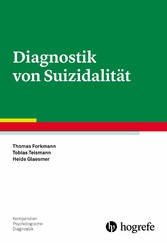
Diagnostik von Suizidalität
von: Thomas Forkmann, Tobias Teismann, Heide Glaesmer
Hogrefe Verlag GmbH & Co. KG, 2015
ISBN: 9783840926396
Sprache: Deutsch
164 Seiten, Download: 2159 KB
Format: PDF, auch als Online-Lesen
| Diagnostik von Suizidalität | 1 | ||
| Vorwort der Herausgeber | 7 | ||
| Inhaltsverzeichnis | 9 | ||
| 1 Einleitung | 13 | ||
| 1.1 Herausforderung Suizidalitätsdiagnostik | 13 | ||
| 1.2 Zur Konzeption dieses Buches | 14 | ||
| 2 Suizidalität | 17 | ||
| 2.1 Definition und Klassifikation suizidalen Erlebens und Verhaltens | 17 | ||
| 2.2 Epidemiologie | 22 | ||
| 2.3 Risikofaktoren | 24 | ||
| 2.4 Ätiologiemodelle | 30 | ||
| 2.5 Allgemeine Probleme bei der Diagnostik suizidalen Verhaltens und Erlebens | 38 | ||
| 3 Screeninginstrumente und Checklisten | 39 | ||
| 3.1 Screeninginstrumente | 39 | ||
| 3.2 Checklisten | 45 | ||
| 3.3 Schlussfolgerung und Empfehlung | 49 | ||
| 4 Interviewverfahren | 50 | ||
| 4.1 Suicide Status Form (SSF-III) | 50 | ||
| 4.2 Self-Injurious Thoughts and Behaviors Interview (SITBI) | 55 | ||
| 4.3 Columbia-Suicide Severity Rating Scale (C-SSRS) | 57 | ||
| 4.4 Suicide Attempt Self-Injury Interview (SASII) | 59 | ||
| 4.5 Schlussfolgerung und Empfehlung | 62 | ||
| 5 Verhaltensdiagnostik bei suizidalem Verhalten | 64 | ||
| 6 Selbstbeurteilungsverfahren | 70 | ||
| 6.1 Beck Scale for Suicidal Ideation (BSSI-S) | 70 | ||
| 6.2 Self-Monitoring Suicide Ideation Scale (SMSI) | 72 | ||
| 6.3 Suicide Behaviours Questionnaire-Revised (SBQ-R) | 73 | ||
| 6.4 Sheehan Suicidality Tracking Scale (Sheehan-STS) – Selbstbeurteilungsversion | 74 | ||
| 6.5 Adult Suicide Ideation Questionnaire (ASIQ) | 76 | ||
| 6.6 Suicide Trigger Scale (STS) | 78 | ||
| 6.7 Schlussfolgerung und Empfehlung | 81 | ||
| 7 Fremdbeurteilungsverfahren | 82 | ||
| 7.1 Beck Scale for Suicidal Ideation (BSSI-F) | 82 | ||
| 7.2 Modified Scale for Suicidal Ideation (MSSI) | 83 | ||
| 7.3 InterSePT Scale for Suicidal Thinking (ISST) | 85 | ||
| 7.4 Sheehan Suicidality Tracking Scale (Sheehan-STS) | 87 | ||
| 7.5 Suicidal Intent Scale (SIS) | 88 | ||
| 7.6 Risk-Rescue-Rating (RRR) | 90 | ||
| 7.7 Lethality of Suicide Attempt Rating Scale-II (LSARS-II) | 92 | ||
| 7.8 Schlussfolgerung und Empfehlung | 95 | ||
| 8 Ergänzende diagnostische Instrumente | 96 | ||
| 8.1 Beck Hopelessness Scale (BHS) | 96 | ||
| 8.2 Reasons for Living Inventory (RFL) | 98 | ||
| 8.3 Suicide Resilience Inventory-25 (SRI-25) | 100 | ||
| 8.4 Positive and Negative Suicide Ideation Inventory (PANSI) | 101 | ||
| 8.5 Skala zur Erfassung der Impulsivität und emotionalen Dysregulation der Borderline-Persönlichkeitsstörung (IES-27) | 103 | ||
| 8.6 Interpersonal Needs Questionnaire (INQ) | 104 | ||
| 8.7 Acquired Capability for Suicide Scale – Fearlessness about Death (ACSS-FAD) | 106 | ||
| 8.8 German Capability for Suicide Questionnaire (GCSQ) | 108 | ||
| 8.9 Painful and Provocative Events Scale (PPES) | 109 | ||
| 8.10 Defeat Scale (DS) | 110 | ||
| 8.11 Entrapment Scale (ES) | 111 | ||
| 8.12 Self-Harm Behavior Questionnaire (SHBQ) | 112 | ||
| 8.13 Deliberate Self-Harm Inventory (DSHI) | 115 | ||
| 8.14 Suicide Opinion Questionnaire (SOQ) | 117 | ||
| 8.15 Suicide Cognitions Scale (SCS) | 119 | ||
| 9 Instrumente für spezifische Altersgruppen | 122 | ||
| 9.1 Kindes- und Jugendalter | 123 | ||
| 9.2 Höheres Erwachsenenalter | 128 | ||
| 9.3 Schlussfolgerung und Empfehlungen | 129 | ||
| 10 Ausblick | 131 | ||
| 10.1 Adaptives Testen | 131 | ||
| 10.2 Ambulatorisches Assessment/„Experience Sampling Method“ | 134 | ||
| 10.3 Nutzung von Apps und Web-Applikationen zum Suizidalitätsassessment | 136 | ||
| 10.4 Implizite Tests | 139 | ||
| 10.5 Zusammenfassung | 141 | ||
| Literatur | 143 |








